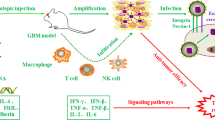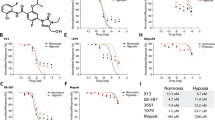Abstract
Suicide gene transfer using thymidine kinase (TK) and ganciclovir (GCV) treatment or the cytosine deaminase (CD)/5-fluorocytosine (5-FC) system represents the most widely used approach for gene therapy of cancer. However, molecular pathways and resistance mechanisms remain controversial for GCV-mediated cytotoxicity, and are virtually unknown for the CD/5-FC system. Here, we elucidated some of the cellular pathways in glioma cell lines that were transduced to express the TK or CD gene. In wild-type p53-expressing U87 cells, exposure to GCV and 5-FC resulted in a weak p53 response, although apoptosis was efficiently induced. Cell death triggered by GCV and 5-FC was independent of death receptors, but accompanied by mitochondrial alterations. Whereas expression of Bax remained unaffected, in particular, GCV and also 5-FC caused a decline in the level of Bcl-2. Similar findings were obtained in 9L and T98G glioma cells that express mutant p53, and also underwent mitochondrial apoptosis in both the TK/GCV and CD/5-FC system. Upon treatment of 9L cells with 5-FC, Bcl-xL expression slowly declined, whereas exposure to GCV resulted in the rapid proapoptotic phosphorylation of Bcl-xL. These data suggest that TK/GCV- and CD/5-FC-induced apoptosis does neither require p53 nor death receptors, but converges at a mitochondrial pathway triggered by different mechanisms of modulation of Bcl-2 proteins.
This is a preview of subscription content, access via your institution
Access options
Subscribe to this journal
Receive 50 print issues and online access
$259.00 per year
only $5.18 per issue
Buy this article
- Purchase on Springer Link
- Instant access to full article PDF
Prices may be subject to local taxes which are calculated during checkout








Similar content being viewed by others
References
Aghi M, Kramm CM, Chou TC, Breakefield XO and Chiocca EA . (1998). J. Natl. Cancer Inst., 90, 370–380.
Asai A, Miyagi Y, Sugiyama A, Gamanuma M, Hong SI, Takamoto S, Nomura K, Matsutani M, Takakura K and Kuchino Y . (1994). J. Neuro-Oncol., 19, 259–268.
Bassik MC, Scorrano L, Oakes SA, Pozzan T and Korsmeyer SJ . (2004). EMBO J., 10, 1207–1216.
Beltinger C, Fulda S, Kammertoens T, Meyer E, Uckert W and Debatin KM . (1999). Proc. Natl. Acad. Sci. USA, 96, 8699–8704.
Beltinger C, Fulda S, Kammertoens T, Uckert W and Debatin KM . (2000). Cancer Res., 60, 3212–3217.
Burek C, Roth J, Koch HG, Harzer K, Los M and Schulze-Osthoff K . (2001). Oncogene, 20, 6493–6502.
Chen L, Marechal V, Moreau J, Levine AJ and Chen J . (1997). J. Biol. Chem., 36, 22966–22973.
Cheng EH-Y, Kirsch DG, Clem RJ, Ravi R, Kastan MB, Bedi A, Ueno K and Hardwick JM . (1997). Science, 278, 1966–1968.
Daniel PT, Schulze-Osthoff K, Belka C and Guner D . (2003). Essays Biochem., 39, 73–88.
Dimmeler S, Breitschopf K, Haendeler J and Zeiher AM . (1999). J. Exp. Med., 189, 1815–1822.
Erhardt P, Tomaselli KJ and Cooper GM . (1997). J. Biol. Chem., 272, 15049–15052.
Essmann F, Bantel H, Totzke G, Engels IH, Sinha B, Schulze-Osthoff K and Janicke RU . (2003). Cell Death Differ., 10, 1260–1272.
Fan M, Goodwin M, Vu T, Brantley-Finley C, Gaarde WA and Chambers TC . (2000). J. Biol. Chem., 275, 29980–29985.
Ferrari D, Stepczynska A, Los M, Wesselborg S and Schulze-Osthoff K . (1998). J. Exp. Med., 188, 979–984.
Fischer U, Janicke RU and Schulze-Osthoff K . (2003). Cell Death Differ., 10, 76–100.
Freeman SM, Abboud CN, Whartenby KA, Packman CH, Koeplin DS, Moolten FL and Abraham GN . (1993). Cancer Res., 53, 5274–5283.
Fridman JS and Lowe SW . (2003). Oncogene, 22, 9030–9040.
Glaser T, Castro MG, Lowenstein PR and Weller M . (2001). Gene Ther., 8, 469–476.
Hamel W, Magnelli L, Chiarugi VP and Israel MA . (1996). Cancer Res., 56, 2697–2702.
Haupt Y, Maya R, Kazaz A and Oren M . (1997). Nature, 387, 296–299.
Ichikawa T, Tamiya T, Adachi Y, Ono Y, Matsumoto K, Furuta T, Yoshida Y, Hamada H and Ohmoto T . (2000). Cancer Gene Ther., 7, 74–82.
Kaneko Y and Tsukamoto A . (1995). Cancer Lett., 96, 105–110.
Kharbanda S, Saxena S, Yoshida K, Pandey P, Kaneki M, Wang Q, Cheng K, Chen YN, Campbell A, Sudha T, Yuan ZM, Narula J, Weichselbaum R, Nalin C and Kufe D . (2000). J. Biol. Chem., 275, 322–327.
Klatzmann D, Phillipon J, Valery A, Bensimon G and Salzmann J-L . (1996). Hum. Gene Ther., 7, 109–126.
Kramm CM, Chase M, Herrlinger U, Jacobs A, Pechan PA, Rainov NG, Sena-Esteves M, Aghi M, Barnett FH, Chiocca EA and Breakefield XO . (1997). Hum. Gene Ther., 8, 2057–2068.
Kramm CM, Niehues T and Rainov NG . (2003). Methods Mol. Biol., 215, 137–152.
Kramm CM, Sena-Esteves M, Barnett FH, Rainov NG, Schuback DE, Yu JS, Pechan PA, Paulus W, Chiocca EA and Breakefield XO . (1995). Brain Pathol., 5, 345–381.
Kubbutat MHG, Jones SN and Vousden KH . (1997). Nature, 387, 299–303.
Los M, Wesselborg S and Schulze-Osthoff K . (1999). Immunity, 10, 629–639.
May P and May E . (1999). Oncogene, 18, 7621–7636.
McMasters RA, Saylors RL, Jones KE, Hendrix ME, Moyer MP and Drake RR . (1998). Hum. Gene Ther., 9, 2253–2261.
Milosevic J, Hoffarth S, Huber C and Schuler M . (2003). Oncogene, 22, 6852–6856.
Miyashita T, Harigai M, Hanada M and Reed JC . (1994). Cancer Res., 54, 3131–3135.
Miyashita T and Reed JC . (1995). Cell, 80, 293–299.
Moolten FL . (1986). Cancer Res., 46, 5276–5281.
Momand J, Zambetti GP, Olson DC, George DL and Levine AJ . (1992). Cell, 69, 1237–1245.
Mullen CA, Kilstrup M. and Blaese RM . (1992). Proc. Natl. Acad. Sci. USA, 89, 33–37.
Nanda D, Vogels R, Havenga M, Avezaat CJ, Bout A and Smitt PS . (2001). Cancer Res., 61, 8743–8750.
Oldfield EH, Ram Z, Culver KW, Blaese RM, DeVroom HL and Anderson WF . (1993). Hum. Gene Ther., 4, 39–69.
Poruchynsky MS, Wang EE, Rudin CM, Blagosklonnny MV and Fojo T . (1998). Cancer Res., 58, 3331–3339.
Rainov NG . (2000). Hum. Gene Ther., 11, 2389–2401.
Rainov NG and Kramm CM . (2001). Curr. Gene Ther., 1, 367–383.
Schilsky RL . (1998). Oncology, 12, 13–18.
Schulze-Osthoff K, Ferrari D, Los M, Wesselborg S and Peter ME . (1998). Eur. J. Biochem., 254, 439–459.
Stroh C and Schulze-Osthoff K . (1998). Cell Death Differ., 5, 997–1000.
Tomicic MT, Thust R and Kaina B . (2002). Oncogene, 21, 2141–2153.
Totzke G, Schulze-Osthoff K and Janicke RU . (2003). Oncogene, 22, 8021–8030.
Van Meir EG, Kikuchi T, Tada M, Li H, Diserens A-C, Wojcik BE, Huang H-JS, Friedmann T, de Tribolet N and Cavanee WK . (1994). Cancer Res., 54, 649–652.
Vousden KH and Lu X . (2002). Nat. Rev. Cancer, 2, 594–604.
Wallace H, Clarke AR, Harrison DJ, Hooper ML and Bishop JO . (1996). Oncogene, 13, 55–61.
Wei J, Blum S, Unger M, Jarmy G, Lamparter M, Geishauser A, Vlastos GA, Chan G, Fischer KD, Rattat D, Debatin KM, Hatzopoulos AK and Beltinger C . (2004). Cancer Cell, 5, 477–488.
Wei SJ, Chao Y, Hung YM, Lin WC, Yang DM, Shih YL, Chang LY, Whang-Peng J and Yang WK . (1998). Exp. Cell Res., 241, 66–75.
Wei SJ, Chao Y, Shih YL, Yang DM, Hung YM and Yang WK . (1999). Gene Ther., 6, 420–431.
Weizsaecker M, Deen DF, Rosenblum ML, Hoshino T, Gutin PH and Barker M . (1981). J. Neurol., 224, 183–192.
Wesselborg S, Engels IH, Rossmann E, Los M and Schulze-Osthoff K . (1999). Blood, 93, 3053–3063.
Wieder T, Essmann F, Prokop A, Schmelz K, Schulze-Osthoff K, Beyaert R, Dörken B and Daniel PT . (2001). Blood, 97, 1378–1387.
Wu Y, Mehew JW, Heckman CA, Arcinas M and Boxer LM . (2001). Oncogene, 20, 240–251.
Xie Y, Gilbert JD, Kim JH and Freytag SO . (1999). Clin. Cancer Res., 5, 4224–4232.
Zimmer C, Wright Jr SC, Engelhardt RT, Johnson GA, Kramm C, Breakefield XO and Weissleder R . (1997). Exp. Neurol., 143, 61–69.
Acknowledgements
This study was supported by grants from the BioRegio program of the German Ministry of Research and Technology (Forschungsverbund Somatische Gentherapie), the Deutsche Forschungsgemeinschaft (DFG Kr1711/1-1), and the Elterninitiative Kinderkrebsklinik Düsseldorf e.V.
Author information
Authors and Affiliations
Corresponding author
Rights and permissions
About this article
Cite this article
Fischer, U., Steffens, S., Frank, S. et al. Mechanisms of thymidine kinase/ganciclovir and cytosine deaminase/ 5-fluorocytosine suicide gene therapy-induced cell death in glioma cells. Oncogene 24, 1231–1243 (2005). https://doi.org/10.1038/sj.onc.1208290
Received:
Accepted:
Published:
Issue Date:
DOI: https://doi.org/10.1038/sj.onc.1208290
Keywords
This article is cited by
-
Mesenchymal stem cells: a trojan horse to treat glioblastoma
Investigational New Drugs (2023)
-
Ultrasound-mediated nanobubble destruction (UMND) facilitates the delivery of VEGFR2-targeted CD-TK-loaded cationic nanobubbles in the treatment of bladder cancer
Journal of Cancer Research and Clinical Oncology (2020)
-
Isocytosine deaminase Vcz as a novel tool for the prodrug cancer therapy
BMC Cancer (2019)
-
The Use of Normal Stem Cells and Cancer Stem Cells for Potential Anti-Cancer Therapeutic Strategy
Tissue Engineering and Regenerative Medicine (2018)
-
Tumoricidal effect of human olfactory ensheathing cell mediated suicide gene therapy in human glioblastoma cells
Molecular Biology Reports (2018)



